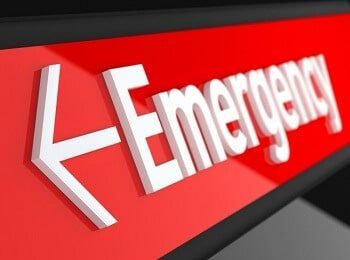How Much Does an Emergency Room Visit Cost Without Insurance?
Last Updated on March 11, 2024
Written by CPA Alec Pow | Content Reviewed by ![]() CFA Alexander Popinker
CFA Alexander Popinker
An emergency room (ER) visit can be extremely expensive, especially if you do not have health insurance. Understanding the potential costs is important to avoid financial shock when you receive the medical bills.
This article will provide an overview of typical ER costs, factors that influence pricing, and ways to manage expenses for uninsured patients. Having the right information can help you make wise choices when a health emergency strikes.
The emergency room provides urgent care for injuries and sudden illnesses. However, treatment does not come cheap. Charges are generally much higher than doctor office or urgent care visits. For uninsured patients, an ER visit often leads to massive medical debt due to the high prices.
How Much Does an Emergency Room Visit Cost Without Insurance?
Emergency room costs vary widely depending on the hospital, location, and services provided. Uninsured patients typically face out-of-pocket charges between $150-$3,000 or more per visit. Here are some typical price ranges:
- Minor treatment like stitches or basic X-rays: $150-$700 – Simple procedures or tests usually cost less, but prices still add up quickly without insurance.
- Moderate treatment like sprains/fractures or CT scans: $700-$1,500 – More complex issues require more resources, driving up charges for the uninsured.
- Major treatment like surgery or hospital admission: $1,500+ – Serious conditions often rack up thousands in medical bills for ER treatment and inpatient care.
According to SmartFinancial, a visit to the emergency room can cost up to $2,200 without insurance, with the average cost in 2021 being $1,150.
GoodRx notes that on average, emergency room visits cost anywhere from $2,400 to $2,600 without insurance.
Debt.org writes that uninsured patients making emergency department visits in 2019 had an average cost of $1,749, with the average expense for people aged 45-64 being $2,285.
According to Mira, the costs for an individual without insurance range anywhere from $80 to $280 for a basic Level I urgent care visit and $140 to $440 for an urgent care visit involving imaging services such as X-rays or ultrasounds.
Keep in mind, that these ranges are just estimates. Actual charges depend on many factors discussed later. Always expect higher prices without insurance, sometimes exponentially higher.
Emergency Room Visits Overview
It helps to understand what constitutes an ER visit when considering potential costs. In general, the emergency room handles urgent medical issues like:
- Accidents and trauma leading to wounds or broken bones
- Sudden, severe pain or pressure (headaches, chest pain, etc.)
- Major burns or electrical shocks
- Seizures, dizziness, or loss of consciousness
- Difficulty breathing or shortness of breath
- Severe bleeding or hemorrhage
- Poisoning or drug overdose
- Complications of pregnancy like bleeding or preterm labor
Anything potentially life-threatening requires emergency care. For less serious matters, an urgent care clinic or doctor’s office may suffice for lower costs.
Cost Factors for ER Visits Without Insurance
Many elements impact the charges for uninsured ER visits, including:
- Services rendered – More extensive treatment, testing, and procedures quickly increase costs. Simple visits are cheapest.
- Staff involved – Doctors, nurses, technicians, and specialists cost more per hour. More personnel equals higher bills.
- Diagnostics/equipment used – X-rays, CT scans, MRIs, and labs carry high price tags, often thousands per test.
- Medications provided – Emergency drugs, injections, IV fluids/medications are all very expensive.
- Facility/hospital fees – Overhead like equipment, utilities, and administration all drive up prices.
- Emergency room type – Trauma centers and hospital-based ERs often cost more than standalone ERs.
- Inpatient admission – If you require hospitalization, additional facility and bed fees apply, which uninsured patients must cover.
Without insurance to negotiate lower prices, ERs bill at full rates. Charges add up very quickly in a crisis scenario.
Comparing ER Costs to Other Medical Services
To put ER expenses in context, compare costs to other healthcare settings without insurance:
- Primary doctor visit – $75-$200 for minor illness or injury.
- Urgent care visit – $100-$350 for issues needing quick attention.
- Retail clinic visit – $40-$125 for basic concerns like flu, rashes, or cuts.
As you can see, the ER costs up to 10x more than other medical facilities for people not under an insurance plan. Prices may even exceed $1,000 for serious emergency issues. Always weigh options carefully before going to the expensive ER.
Financial Assistance and Payment Options
Uninsured patients have some options to reduce or defer medical bills from an ER visit:
- Payment plans – Most hospitals offer interest-free monthly payments, often lasting 6-12 months.
- Discounts – Ask if the hospital provides any prompt-pay or self-pay discounts. These offer 20-30% off medical bills.
- Charity care – Based on income, hospitals may forgive part or all of an uninsured patient’s ER charges.
- Government aid – Medicaid may provide retroactive coverage if you qualify after an ER visit.
- Crowdfunding – Using GoFundMe and similar websites to ask for public donations is an option.
- Medical credit cards – Special credit cards help finance medical ER bills over time for qualifying applicants.
- Hospital legal aid – Many facilities offer assistance in disputing excessive charges or obtaining aid.
Talk to hospital billing representatives about these potential options after an ER visit. Uninsured patients have rights and avenues to alleviate costs.
You might also like our articles about the cost of endoscopy, antibiotics, or emergency dentists without insurance.
The Impact of Location and Hospital Type
 Where you receive emergency care significantly impacts costs. Prices vary based on:
Where you receive emergency care significantly impacts costs. Prices vary based on:
- State and region – Overall healthcare expenses are lower in rural and Southern states versus coastal, and urban areas.
- Public, charity, or private hospital – Government and nonprofit hospitals offer more financial assistance and discounted care.
- Hospital size/level of care – Major medical care centers and teaching hospitals are the most expensive.
- Independent vs. hospital-based ER – Freestanding ERs tend to have lower facility fees.
- In-network vs. out-of-network – Insurers negotiate lower in-network rates excluded from out-of-network ERs.
Research hospital options when possible to identify affordable emergency care in your region as an uninsured patient. Location makes a big cost difference.
Avoiding Unnecessary ER Visits
The ER remains essential for true health emergencies, but far too many visits occur for minor concerns. Here are tips to avoid costly, unnecessary ER trips:
- Visit an urgent care center or doctor’s office for basic illness or injuries.
- Call your primary care physician for guidance to evaluate urgency if unsure.
- Use telemedicine apps for on-demand expert consultations.
- Go to retail clinics in major pharmacies for basic care needs.
- Treat small wounds at home or visit an outpatient clinic.
- Allow fevers, vomiting, diarrhea, etc. to improve over 24 hours before seeking ER care.
- Call 911 instead for true emergencies like chest pain, loss of consciousness, etc.
Staying out of the ER unless absolutely necessary is the #1 way for uninsured patients to control costs. Seek care in lower-priced settings when the situation allows.
Final Words
Emergency rooms provide critical, life-saving care but frequently create financial hardship for uninsured patients. Typical ER visits cost hundreds to thousands of dollars out-of-pocket without health coverage.
Always understand your options to keep expenses as low as possible in an urgent medical situation. With the right information and choices, you can get the emergency care you need while minimizing costs.
Frequently Asked Questions
Is emergency care free in the USA?
No, emergency care is not free in the USA, even for those without health insurance coverage. Under the Emergency Medical Treatment and Labor Act (EMTALA), hospitals must medically screen and stabilize patients who come to an emergency room, regardless of their ability to pay.
However, this law only requires urgent stabilizing treatment and does not cancel out hospital charges. Uninsured patients can still receive large medical bills they are responsible for paying.
Hospitals may offer financial assistance or payment plans, but emergency room care is not free. Having health insurance or utilizing lower-cost options like urgent care for non-emergencies is wise to limit expenses as much as possible. But the emergency room always remains an option in true health crises despite costs.
What is the best time to go to the ER?
The best time to visit the emergency room is when you have an urgent medical problem requiring immediate care. This includes potentially life-threatening issues like chest pain, difficulty breathing, sudden numbness/weakness, major trauma or burns, severe bleeding or pain, poisoning, complications of pregnancy, or any situation where you reasonably fear for life or limb without instant treatment.
For these critical matters, the ER provides essential services at any hour of the day or night. However, for non-urgent issues, the ER may not be the wisest choice due to high costs for uninsured patients.
Weekday mornings and afternoons tend to be less crowded if your condition allows flexibility. Always call 911 or have someone drive you for serious emergencies regardless of the hour.
What happens if a tourist gets sick in the USA without insurance?
If a tourist becomes ill or injured while visiting the USA without traveler’s insurance, they can still receive emergency treatment but will face high medical costs. By law, hospitals must medically screen and stabilize patients in the ER regardless of insurance status or ability to pay. However, the uninsured tourist will later receive hospital bills they are responsible for paying.
Tourists in the U.S. should take steps to manage potential medical costs in case of emergency:
- Purchase comprehensive travel insurance covering health emergencies abroad. This is the best option to limit expenses.
- Bring prescription medications and first aid supplies to treat minor issues yourself.
- Carry your passport and any payment methods for healthcare.
- Confirm your home country will cover costs for any government-funded care.
- Ask about discounted rates or financial assistance at U.S. hospitals.
- Request an itemized bill and check for errors after treatment.
- Inquire if the hospital offers interest-free payment plans.
- Consider returning home for any follow-up care or procedures.
With proper preparation, travelers can still enjoy their U.S. visit with less worry about medical costs. But having insurance or access to funds is essential to cover unexpected healthcare needs away from home.


Leave a Reply
Want to join the discussion?Feel free to contribute!